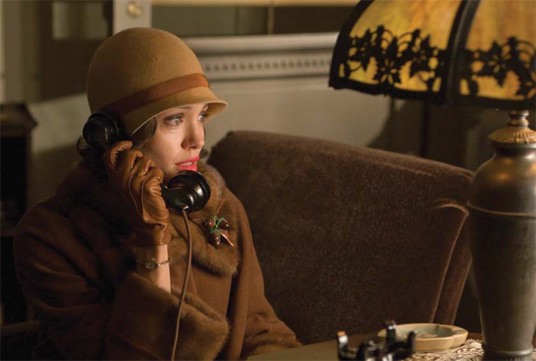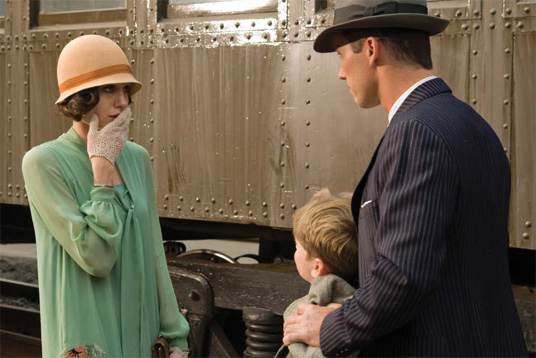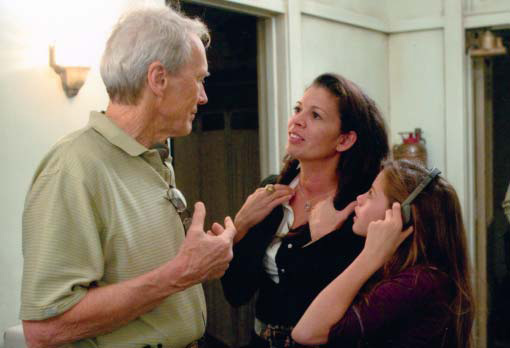
At press time, Clint Eastwood was putting the finishing touches on his upcoming film,“Changeling,” starring Angelina Jolie. Jolie plays the part of a mother whose son is abducted, and then supposedly returned to her by the Los Angeles Police Department. When Jolie’s character, Christine Collins, protests that the boy who has been brought back to her is not her son, she is placed in a psychiatric ward.
The movie, set in Los Angeles in the late 1920s, is based on a true story. Eastwood shared with Carmel Magazine some of the process of making the movie and his appreciation of Angelina Jolie’s acting.
Carmel Magazine: “Changeling” is based on a true story. How close did you feel that you had to stick to the subject matter?
Clint Eastwood: Well, I stuck with it as close as the knowledge allows us. Our screenwriter took it all from newspaper articles and photographs of the ’20s. Christine Collins, who is being portrayed by Angelina Jolie, probably wasn’t as glamorous as pictured [by Jolie], but she was a working woman for the phone company in 1928, a supervisor, and she was put through the wringer by the LAPD, and the whole government system in Los Angeles at that time, to the point where they even sent her to the psychiatric ward.
CM: That’s almost unbelievable.
CE: Yeah it is. It almost sounds fictional. But it actually happened, so it’s kind of a fascinating
story, and it’s a wonderful part for [Jolie] and a wonderful part for a lot of other people in there
as well.
CM: There are obviously some very painful emotions for a mother that she portrayed. How did you direct her to bring those out, or did you mostly see how she presented it?
CE: She had a very good understanding of the part and we just worked with it and you just kind of get in it, into the flow of things. Anybody with any imagination can put themselves in that position and how panicky they would be. The LAPD eventually brought her another kid and said this was her kid and of course she didn’t believe that but she was so stressed at that point that they talked her into taking him home on a trial basis. She thought maybe in the five months [since her son disappeared] that…she was losing her own confidence in [her judgment].
CM: That she couldn’t recognize her own child?
CE: That she was hallucinating. I don’t know if you remember the movie, “Gaslight”?
CM:Yes, exactly.
CE: It was with Charles Boyer and Ingrid Bergman. He makes her think she is going crazy. And this is kind of what they do to [Christine Collins] in a way. And she has great doubts, but there’s a Presbyterian minister at that time who had a war with the LAPD. And so he kind of comes and inspires her to continue on and fight the good fight. And she eventually brings down the whole city government.

CM: Wow. And how was John Malkovich in the role of the minister?
CE: Great. He’s terrific.We have a lot of wonderful actors. The police chief and the police captain are excellent parts, and the detective who discovers the ranch where these kids were being abducted. There are a lot of wonderful parts. It’s an ensemble piece; it’s very nice. But it’s the woman’s story, and she’s terrific.
CM: Now is it accurate that you prefer to try to get everything in one take?
CE: No, that’s a rumor that everyone likes to throw around, because I’m very decisive, and if I see something I like, I go for it. I’m at the age where I’m not intimidated by the materials yet. (Laughs) But if I have any virtue at all in this, it’s that I’m fairly decisive, I can move on. But I’m trying for it at the first take. I don’t always get it. I think it’s something I learned from Don Siegel years ago. If you’re always trying for it on the first take, then everyone else is trying for it with
you. If you’re not trying for it, if you’re kind of saying,‘Well, we’ll shoot a few of these, and see how they come out,’ then no one steps up to bat. They sort of crescendo into it rather than just jump in.
CM: And are you fairly hands-off in your directing?
CE: It depends on what the needs are of the individual. If the individual actor has a pretty good line on the character, then I will encourage he or she to follow that line, and if not, then I’ll tell them what needs to be, more of this or that, it just depends. Sometimes you work with a person and they’re right on key, and then other times you work with people and they have trouble finding it. If they’re having trouble finding it and they come to work and they’ve had all these weeks of prep, then it’s indicative that it might not be the easiest one you’re going to do. But [Jolie] is a very instinctive actress, very well prepared. So it was a pleasure working with her.
CM:Was there a particular scene that was the hardest for her—or for you—to bring out?
CE: I don’t know if there was one that was particularly the hardest. There were a couple, but looking back on it, they all seemed to go relatively well.
CM: And you finished very quickly, didn’t you?
CE:Well, it took nine weeks, which is longer than average for me. But for this picture, the production end, and the amount of people, and the amount of things, made it a little more difficult than doing a smaller picture, like “Million Dollar Baby,” as an example .You only have three or four players, and that’s it. But also the major difficulty is shooting the period. Los Angeles physically has changed since 1928, as most cities have.The skyline is different so we have a few visual effects where we have to adjust the city and make it look like it was then. We brought back the red car, which was their streetcar. With visual effects you have to put the wires on up above that they ride on, and with the tracks, you can’t dig up all the streets and lay steel tracks, so we had to do a little adjusting there, things like that. But nowadays that part is fairly easy. It’s a little bit time consuming because you have to wait for that. That’s where I am right now. The picture is all edited together, but I’m waiting for the visual effects before I can do the final wrap-up on it.
CM: And your daughter, Morgan, had a small part in the movie?
CE: Oh yeah, she had a little one-liner.
CM: Do you think she wants to be an actress?
CE: I don’t know what she wants to do. But she liked doing the one-liner and we had fun doing it. She and [my wife] Dina came down on the set, and Morgan was very good. She doesn’t think too much, she just jumped right in. She follows direction really well. She and a little friend of hers were in this little scene where Angelina asks them something.

CM: And you also had Dawn Flood, I believe, who is a local actress, who played a nurse?
CE: Yes, she asked if she could audition and she did great, so we put her in.
CM: And then Clint Ward, another local actor, was in it as well.
CE:Yes.We’ll see how they hang out in the final cut.
CM: Oh yeah, you never know.
CE:You never know, because sometimes with long pictures…but they both did very well.
CM:Anything else about this particular film that was distinctive for you?
CE: Angelina is a throwback, in my opinion, to the great actresses of the ’40s. Think of the actresses of the “golden age” of movies, actresses like Ingrid Bergman, Katherine Hepburn. She is a very striking looking woman and equally as good of an actress.